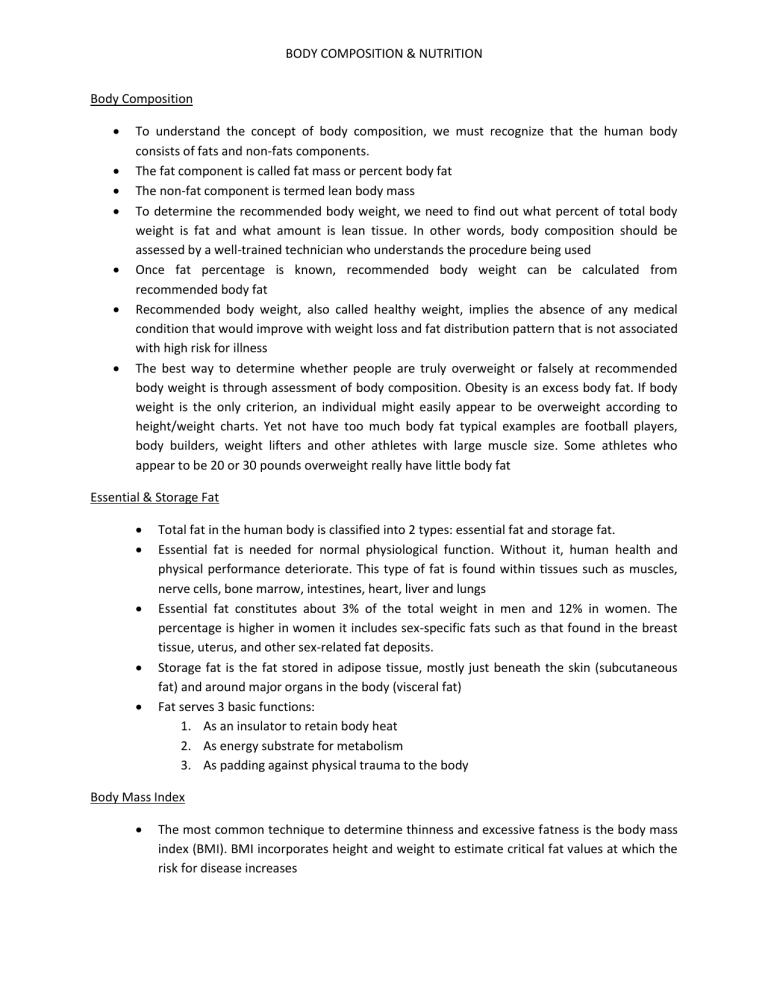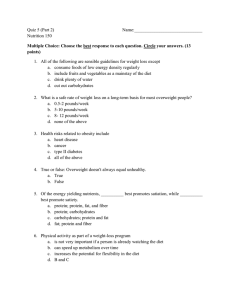
BODY COMPOSITION & NUTRITION Body Composition To understand the concept of body composition, we must recognize that the human body consists of fats and non-fats components. The fat component is called fat mass or percent body fat The non-fat component is termed lean body mass To determine the recommended body weight, we need to find out what percent of total body weight is fat and what amount is lean tissue. In other words, body composition should be assessed by a well-trained technician who understands the procedure being used Once fat percentage is known, recommended body weight can be calculated from recommended body fat Recommended body weight, also called healthy weight, implies the absence of any medical condition that would improve with weight loss and fat distribution pattern that is not associated with high risk for illness The best way to determine whether people are truly overweight or falsely at recommended body weight is through assessment of body composition. Obesity is an excess body fat. If body weight is the only criterion, an individual might easily appear to be overweight according to height/weight charts. Yet not have too much body fat typical examples are football players, body builders, weight lifters and other athletes with large muscle size. Some athletes who appear to be 20 or 30 pounds overweight really have little body fat Essential & Storage Fat Total fat in the human body is classified into 2 types: essential fat and storage fat. Essential fat is needed for normal physiological function. Without it, human health and physical performance deteriorate. This type of fat is found within tissues such as muscles, nerve cells, bone marrow, intestines, heart, liver and lungs Essential fat constitutes about 3% of the total weight in men and 12% in women. The percentage is higher in women it includes sex-specific fats such as that found in the breast tissue, uterus, and other sex-related fat deposits. Storage fat is the fat stored in adipose tissue, mostly just beneath the skin (subcutaneous fat) and around major organs in the body (visceral fat) Fat serves 3 basic functions: 1. As an insulator to retain body heat 2. As energy substrate for metabolism 3. As padding against physical trauma to the body Body Mass Index The most common technique to determine thinness and excessive fatness is the body mass index (BMI). BMI incorporates height and weight to estimate critical fat values at which the risk for disease increases BODY COMPOSITION & NUTRITION BMI is calculated by either dividing the weight in kilograms by the square of the height in meters or multiplying body weight in pounds by 703 and dividing this figure by the square of the height in inches. For example, the BMI for an individual who weighs 172 lbs (78 kg) and is 67 in (1.7 m) tall would be 27. You also look up your BMI in table 4.6 according to the height and weight 𝑘𝑔 703 × 𝑙𝑏𝑠 𝐵𝑀𝐼 = 2 = 𝑚 𝑖𝑛2 Because of its simplicity and measurement consistency across populations, BMI is the most widely used method to determine overweight and obesity. Due to the various limitations of previously mentioned body composition techniques including: Lack of consistently among technician and laboratories Cost Availability to the general population Inconsistent results between techniques Standard errors of measure of the procedures BMI is used almost exclusively to determine health risk and mortality rates associated with body weight BMI: Underweight: <18.5 Normal: 18.5-24.9 Overweight: 25-29.9 Obese: 30-34.9 Extremely obese: >35 Nutrition science that interprets the interaction of nutrients and other substance in food in relation to the maintenance, growth, reproduction, health and disease of an organism Nutrients: a substance that provides nourishment essential for growth and the maintenance of life two types: 1. macronutrients: different types of nutrients we consume in large amounts and these are measured in grams (carbohydrates, proteins, and fats) 2. micronutrients: vitamins and minerals; the prefix micro is used because the body’s daily requirements for these nutrients are small (vitamins and minerals) Carbohydrates compounds constructed by carbon, hydrogen and oxygen converted into glucose in the body, providing main source of fuel (4 calories per gram of carbohydrate) for all physical activity carbohydrates are found in a wide variety of foods including grains, fruits and vegetables as well as in the milk/alternative (soy, rice, nut, or other non-dairy products) groups BODY COMPOSITION & NUTRITION Proteins amino acids are the building blocks of proteins constructed by carbon, hydrogen, oxygen and nitrogen molecules amino acids can be made within the body (nonessential) or required from dietary sources (essential) involved in the development and growth, and repair of muscle and other bodily tissues and are therefore critical for recovery for intense physical training ensure the body stays healthy and continue working efficiently by aiding in many bodily processes Fats consists of oils and fat-like substances found in foods such as cholesterol and phospholipids are commonly referred to as lipids with 9 calories per gram, fats are a concentrated source of energy primarily used as a fuel at rest and during low to moderate intensity exercise involved in providing structure to cell membranes, aiding in the production of hormones, lining of nerves for proper functioning and facilitating the absorption of fat-soluble vitamins Vitamins large class of nutrients that contain carbon and hydrogen as well as possibly oxygen, nitrogen and other elements 2 main requirements for a substance to be classified as a vitamin 1. The substance must be consumed exogenously because the body can’t produce it or can’t produce it in sufficient quantities to meet its need 2. Substance must be essential to a t least one vital chemical reaction or process in the human body Minerals Have a role in the structural development of tissues and regulation o bodily processes Physical activity places demands on muscles and bones, increases the need for oxygencarrying compounds in the blood, and increases the loss of sweat and electrolytes from the body, all of which hinge on the adequate intake and replacement of dietary minerals Categorized into Major minerals: calcium, sodium magnesium, potassium, chloride, phosphorous, and sulfur Trace minerals: iron, zinc, copper, selenium, iodide, fluoride, molybdenum and manganese based on the total quantity required on a daily basis Similar to vitamins, minerals are found in a wide variety of foods but mainly are concentrated in the meats and beans/alternatives and milk/alternative groups BODY COMPOSITION & NUTRITION




